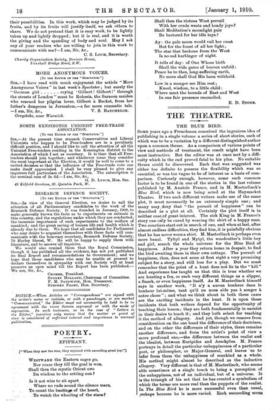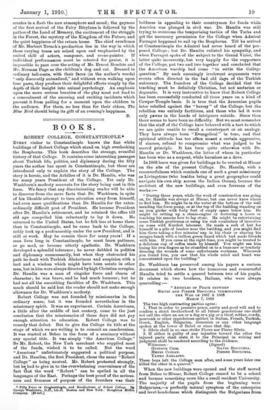THE THEATRE.
THE BLUE BIRD.
SOME years ago a Frenchman conceived the ingenious idea of publishing in a single volume a series of short stories, each of which was to be a variation by a different distinguished author upon a common theme. As a comparison of various points of view and methods of treatment, the result might have been most instructive. But the editor was at once met by a diffi- culty which in the end proved fatal to his plan. No suitable theme could be discovered. Each that was suggested was either too definite to possess the flexibility which was so essential, or was too vague to be of interest as a basis of com- parison. Curiously enough, however, some such common factor is to be found in one of the stories in the last volume published by M. Anatole France, and in M. Maeterlinck's Blue Bird, which is now being acted at the Haymarket Theatre. If two such different writers make use of the same plot, it must necessarily be an extremely simple one; and many may deny that " the pursuit of happiness " can be described is a plot at all. Certainly the plot itself is in neither case of great interest. The sick King in M. France's story can only be cured by wearing the shirt of a happy man. Two courtiers start out in search of one, and when at last, after almost endless difficulties, they find him, it is painfully obvious that he has never worn a shirt. M. Maeterlinck is perhaps even more banal. Tyltyl and Mytyl, the woodcutter's little boy and girl, search the whole universe for the Blue Bird of happiness. After a year they return home in despair, to find the bird awaiting them in their own cottage. The- pursuit of happiness, then, does not seem at first sight a very promising subject for a story, and still less for a play. But we must remember that the point of a hunt does not lie in the " kill." And experience has taught us that this is true whether we are hunting a fox, or such very different things as a slipper, a Snark, or even happiness itself. As M. Maeterlinck himself says in another work, "11 n'y a aucun bonheur dana le bonheur lui-meme, tant qu'il ne nous aide pas h conger h autre chose " ; and what we think about in both these cases are the exciting incidents in the hunt. It is upon these incidents that both writers depend for the opportunity of teaching their lesson; they are both fundamentally in earnest in their desire to teach it ; and they both select for teaching it the method of allegory. And yet, though we remove from consideration on the one hand the difference of their doctrines, and on the other the difference of their styles, there remains another difference, and from the artist's point of view a more profound one,—the difference between the realist and the idealist, between Euripides and Aeschylus. M. France portrays in detail the particular unhappinesses of a pirticular poet, or philosopher, or Major-General, and leaves "us to infer from them the unhappiness of mankind as a whole. His method might almost be described as the inductive allegory. Very different is that of M. Maeterlinck, who seems able sometimes at a single touch to bring a perception of the unhappiness, not of an individual, but of a universe. It is the triumph of his art that he has created a symbolism of which the terms are more real than the puppets of the realist. In The Blue Bird he is more successful even than usual, 3erhaps because he is more varied. Each succeeding scene creates in a flash the new atmosphere and mood ; the gayness of the first arrival of the • Fairy 10xylune is followed by the pathos of the Land of Memory, the excitement of the struggle in the Forest, the mystery of the Kingdom of the Future, and the quiet happiness of the return home. The chief excellence of Mr. Herbert Trench's production lies in the way-in which these varying tones are seized upon and emphasised by the united skill of actors, composer, and scene-painter. If individual performances must be selected for praise, it is impossible to pass over the acting of Mr. Ernest Hendrie and Mr. Norman Page as the children's dog and cat. Dressed in ordinary tail-coats, with their faces (in the author's words) " only discreetly animalized," and without even walking upon four paws, they produce their delightful effects simply by the depth of their insight into animal psychology. An emphasis upon the more serious beauties of the play must not lead to a concealment of the amusing and exciting incidents which prevent it from palling for a moment upon the children in the audience. For them, no less than for their elders, The Blue, Bird should bring its gift of an evening's happiness.
B.















































 Previous page
Previous page